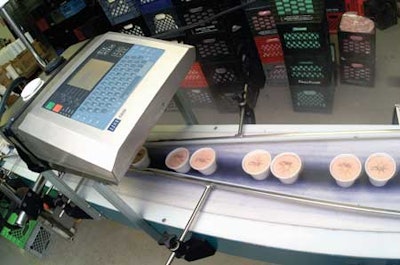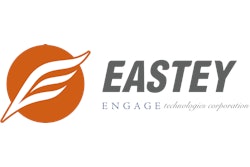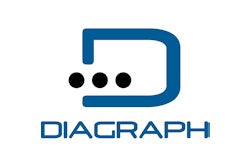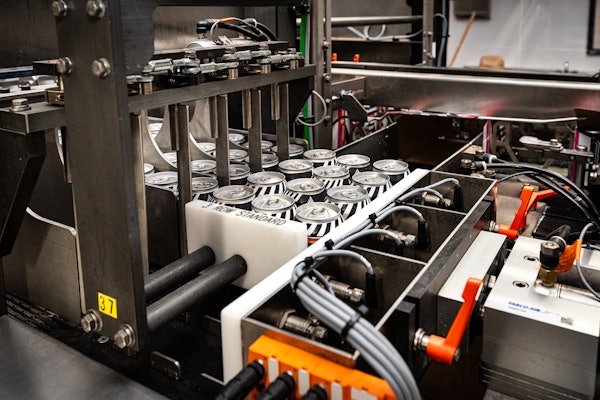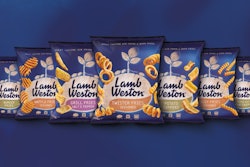Reliability is a key factor behind many of the packaging machinery decisions made at Mister Cookie Face, an ice cream sandwich manufacturer headquartered in Lakewood, NJ. If an ink-jet coder on any one of its seven lines goes down, that entire line shuts down. So engineers at the frozen treat manufacturer decided to switch from labeling systems equipped with air-blow tamp-pad applicators to Linx ink-jet systems from Diagraph. Not only were the old gravity-fed ink-jet systems less reliable and maintenance-intensive, the new systems are saving money in labor, parts, and ink usage.
“Our plant is a very busy place with no tolerance for problems,” says Mahesh Khemraj, production manager at Mister Cookie Face. “On our seven lines, we’re constantly changing over from one product to another. We have some difficult environmental conditions, such as water and refrigeration. We’re always under pressure to maintain tight production schedules, and we run the plant equipment 20 hours a day. So we can’t afford a marking system that’s prone to breakdowns. The truth is, we can’t even accept a system that requires any babying.”
The company chose the Linx systems because they’re easy to use, they’re fast, and they’re reliable, Khemraj says. He adds that operators “just turn them on in the morning, shut them off at the end of the day, and clean the heads maybe once a month.”
The first Linx unit was installed on a test basis in May, 2002. The additional six were purchased after the yearlong pilot period ended.
“The unsatisfactory experience we had with the gravity-fed ink-jet systems made us cautious, so we tested the first Linx 4800 over time,” says Khemraj. “But after a full year of constant use, we knew for sure that Linx systems would be reliable in our tough, high-volume conditions, so making the decision to equip all of our production lines with Linx systems was pretty easy at that point,” he says.
Marking made easy
Five Linx 4800 small-character ink-jet printers are employed on the company’s dry production lines to put date codes on the lids of ice cream cups, packaging for ice cream sandwiches, as well as the paperboard boxes in which they’re packed. Mister Cookie Face also installed two Linx 6800 small character ink-jet systems with stainless-steel IP-65 enclosures on its two wet manufacturing lines. A Diagraph IV/700 large-character ink-jet system marks date and time codes on all corrugated shipping containers.
The seven small-character ink-jet printers are used to mark Julian dates, production line numbers, and time codes on all primary packages.
“In case of a recall, we know when it was made and when it was boxed, which might only be three minutes apart,” Khemraj says.
All of the Linx printers are installed with the printheads positioned above the production lines for a downward printing action. According to Khemraj, “it makes for a very efficient operation because there’s only a minimum amount of cables and brackets required, and the printheads are up and out of the way.”
On the dry production lines, the Linx 4800 systems mark up to 140 products/min. The packaging lines begin as the six-count clamshell packages filled with frozen product are conveyed from the freezer to the labeling station. Brand labels are applied to the top and bottom of the package via a Diagraph LA 1000 wipe-on labeler. After the labels are applied, the Linx system prints the ink-jet code on the top label. The packages are conveyed to a Kalfass Servo Jet shrink wrapper. Packages are conveyed through an Eastey heat tunnel and then through a Lock metal detector. Completed packs are placed by hand into corrugated boxes for warehousing and shipment.
On the wet production lines, which are utilized for the ice cream cups, pints, and half gallons of ice cream, the containers are dispensed and filled with ice cream on a Norse Dairy filler. The containers are conveyed under the printing system that marks up to 190 containers/min. Packs are then conveyed under another Lock metal detector, followed by a freeze tunnel. The frozen containers are placed by hand into shipping cases that are also marked by a Diagraph printer.
Think ink
According to Khemraj, the drying time of the ink is also quite important to Mister Cookie Face. He says they require a drying time of no more than two seconds, “and the ink from the Linx systems dries even faster than that.”
“We like the water tightness of the Linx 6800 stainless-steel enclosure,” he continues. “They stand up to the frequent washdowns that occur on our wet production lines. And because of the cool environment, the heat sensors in the printheads are very helpful because they constantly check and adjust ink viscosity.”
By the end of this year, Mister Cookie Face plans on moving into a new 90ꯠ sq’ plant, as well as adding many additional production lines. Khemraj says the company will certainly add more Linx ink-jet printers to those lines.
“The equipment runs great and we’re very happy with the reliability,” he says. “The first Linx 4800 printer we bought, which is actually used on one of our slower production lines, has given us more than 50 million maintenance-free printing cycles. And it’s still going strong!”
